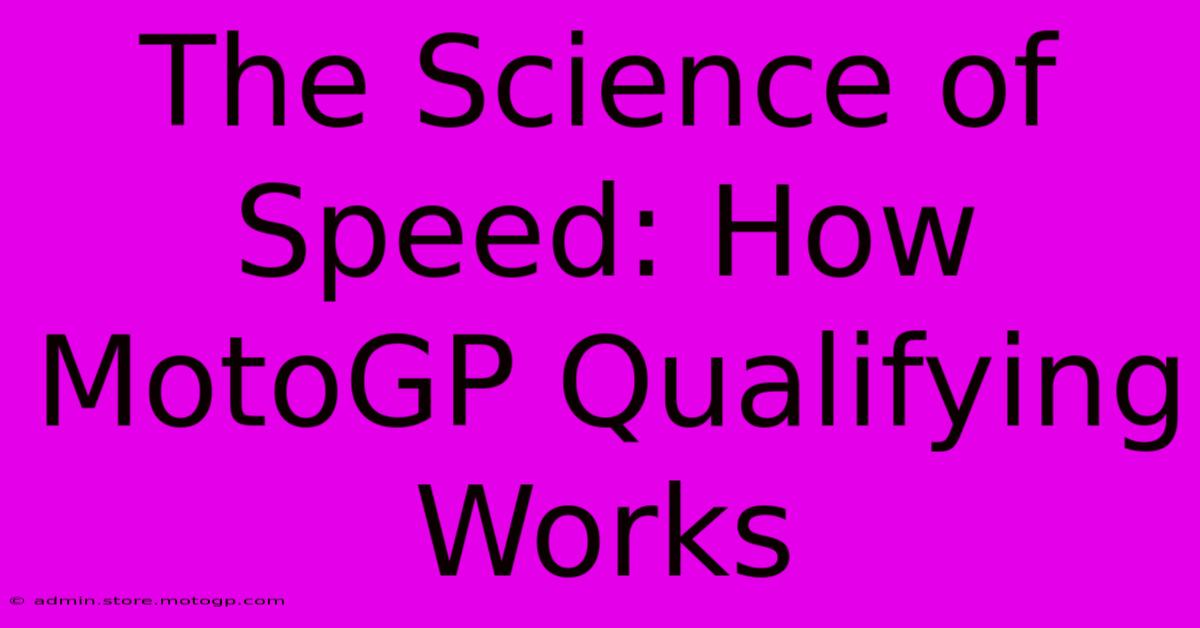The Science Of Speed: How MotoGP Qualifying Works

Table of Contents
The Science of Speed: How MotoGP Qualifying Works
MotoGP, the pinnacle of motorcycle racing, isn't just about raw power; it's a finely tuned dance between rider skill, machine precision, and strategic thinking. Nowhere is this more evident than in qualifying, a crucial session determining grid positions for the race. Understanding how MotoGP qualifying works reveals a fascinating blend of science, strategy, and high-stakes competition.
Understanding the Qualifying Format
The current MotoGP qualifying format is designed to maximize drama and showcase the riders' skill. It's a multi-stage process culminating in a final shootout for pole position.
Q1: The First Cut
The session starts with Q1, where the riders who didn't finish within the top 10 of the combined free practice sessions (FP1, FP2, FP3) compete. This is a high-pressure environment; only the two fastest riders from Q1 advance to Q2. The remaining riders start the race from positions 13-24. This initial phase emphasizes consistency and finding a good setup on the bike. Minor mistakes can be costly here.
Q2: The Fight for Pole
Q2 is where the drama truly unfolds. The top 10 riders from the combined free practice sessions, along with the two qualifiers from Q1, battle for the coveted pole position and the front row starting spots. The competition is fierce, with riders pushing their bikes and themselves to the absolute limit in a desperate bid for a strategic advantage in the race.
Lap times are everything in Q2. A single tenth of a second can mean the difference between pole and a less favorable starting position. The qualifying process is not just a time trial; it's a psychological battle as riders try to understand their competitors' pace and strategies.
The Science Behind the Speed
The quest for speed in MotoGP qualifying isn't just about brute horsepower; it's a delicate balance of numerous factors:
1. Aerodynamics: Cutting Through the Air
Aerodynamics play a crucial role. The bikes are designed with aerodynamic wings and fairings to minimize drag and maximize downforce at high speeds. Even subtle changes to the bike's setup, such as wing angle or ride height, can significantly impact lap times. Teams spend countless hours in wind tunnels and simulations to optimize aerodynamic performance.
2. Tire Management: Grip is Key
Tire choice and management are critical. Riders must select the right tires for track conditions and balance grip with tire wear. Pushing too hard early can lead to tire degradation, costing valuable time in the latter stages of qualifying. The strategy here is finding the right balance between pushing for a fast lap and conserving the tires for a potential race.
3. Suspension Setup: Finding the Sweet Spot
Suspension setup significantly influences a bike's handling and stability. Finding the optimal suspension settings for a specific track is essential for maximizing corner speed and stability under braking. Small adjustments to the suspension can drastically alter a bike's behavior, making this area a crucial aspect of qualifying performance.
4. Engine Performance and Mapping: Tuning for the Track
Engine performance and mapping are optimized for specific tracks. Teams meticulously adjust engine settings to maximize power output and torque delivery based on the track characteristics. Each corner demands a different level of power and torque, so fine-tuning engine parameters is crucial.
5. Rider Skill and Technique: The Human Element
Finally, let's not forget the rider's skill and technique. The ability to push the bike to its limits while maintaining control is paramount. A rider's skill in braking, cornering, and accelerating directly translates to faster lap times. Experience and precision are crucial elements in qualifying.
Off-Track Strategies: The Bigger Picture
Beyond the technical aspects, strategic thinking extends beyond the track:
- Tire strategy: Choosing the right tires for qualifying based on track conditions and weather forecasts.
- Slipstreaming: Utilizing the slipstream of other riders to gain speed on the straights.
- Track conditions: Observing track conditions and adjusting setup according to tire grip and temperature.
- Teamwork: The collaboration between the rider, crew chief, and engineers in analyzing data and making real-time adjustments.
MotoGP qualifying is a complex interplay of scientific precision, strategic planning, and sheer rider skill. It's a spectacle of speed, showcasing the pinnacle of motorcycle racing technology and human ability. Mastering this process is the key to securing a favorable starting position and a strong chance at race victory.

Thank you for visiting our website wich cover about The Science Of Speed: How MotoGP Qualifying Works. We hope the information provided has been useful to you. Feel free to contact us if you have any questions or need further assistance. See you next time and dont miss to bookmark.
Featured Posts
-
F1 Austin The Ultimate Weekend Getaway Awaits
Feb 18, 2025
-
Express Your Passion Moto Gp Replica Helmets
Feb 18, 2025
-
Unleash Your Inner Racer Own A Moto Gp Legend
Feb 18, 2025
-
Get Set What Time Is The Sprint Race
Feb 18, 2025
-
Moto2 Bike Specs The Essential Guide For Racers
Feb 18, 2025
